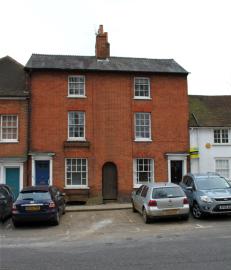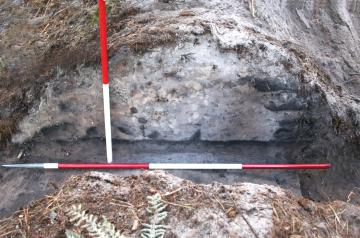Waverley
Watching brief at 23 Castle Street, Farnham 2011-12
Watching brief by D Graham of SyAS in advance of building work. Evidence was found that the southern brick boundary wall had been built on top of and on the same alignment as a medieval ditch, which probably marked the line of the original 12th century burgage plot. The ditch had been cut by a later building, possibly 15th/16th century in date, which appeared to extend across width of the garden, and was probably contained within the curtilage of the plot.
Daniel Hall, Long Garden Walk, Farnham, 2013
Watching brief by D Graham of SyAS on the conversion of a late 18th century barn in 2013. Apart from a possible clay/chalk floor and signs of an episode of burning, there was no evidence for any activity on the site other than the remains of a shallow brick wall running across the centre of the building. The bricks were relatively modern, but underlay the concrete floor and probably represent the line of an earlier partition wall. It seems likely that the area was either open fields or backlands until the barn was constructed in the late 18th century.
Farnham Heath: section through parish boundary 2006
Excavation of a section across the Frensham and Tilford parish boundary at SU 8540 4340.
For more information please view the attached report.
Farnham Castle terrace wall report, 2006
Evaluation by D Graham of SyAS to examine the condition of the southern curtain wall and inform remedial works. The remains of an earlier, possibly 17th century, retaining wall was revealed.
For more information please view the attached report.
Farnham Castle (Wayneflete's Tower) pipeline trench 2006
Watching brief by D Graham of SyAS during the excavation of a pipeline trench at Wayneflete’s Tower (SU 83753 47254). Little of archaeological interest was revealed in an investigation that was too limited to intrude into archaeologically significant levels. It was apparent that the ground around the tower had been raised by around 0.5m, suggesting that any subsequent intrusions below this depth will damage archaeological remains.
For more information please view the attached report.
Farnham Castle new car park report, 2007
Watching brief and resistivity survey by D Graham of SyAS during topsoil removal to create additional car parking spaces. The site lies outside the area of the former (now filled in) inner bailey ditch, and no features were detected. A number of finds were recovered during the topsoil removal, however, including a number of musket and pistol balls, and three powder caps from gunpowder flasks. An incursion of parliamentary forces into the castle courtyard occurred on 26 November 1642, with the royalist garrison surrendering as a result.
Excavation at 17 Red Lion Lane (Bridge Square), Farnham, 1969
Trial trenching inside 17 Red Lion Lane (Brudge Square), Farnham (SU 8411 4652) showed two earlier phases of building: one earlier medieval, one 15th century, underlying the existing cottage.
For more information please view the attached report.
A Roman site on Frensham Manor, Frensham 2001
Trial trenching in fields at Frensham Manor (centred SU 8396 4045) in 2001 located a Roman occupation site which survives below plough soil level and would appear to represent the remains of a small farmstead dating from the late 1st to the 3rd centuries AD. Finds of redeposited fragments of highly fired clay flooring point to the presence of a kiln in the immediate vicinity and metal detector finds from adjacent fields are indicative of further Roman activity in the area.
Excavation at 1 and 2 Church Cottages, Farnham, 1969
No evidence was found of any occupation earlier than 19th century in date and the lack of finds would seem to indicate that there was no settlement in the immediate area.
For more information please view the attached report
Evaluation at West Surrey College of Art and Design, Falkner Road, Farnham 1994
As a result of this work, 1 Roman coin and 1 piece of RB roof tile was found with a very light scatter of medieval and post-medieval pottery and modern building debris. Apart from the pit and redeposited material in trench 25, no archaeological features were found.
A metal detector survey was carried out by members of a local club, who recovered a 17th century trader's token, but otherwise only found post-medieval (mostly 19th and 20th
century) material.


